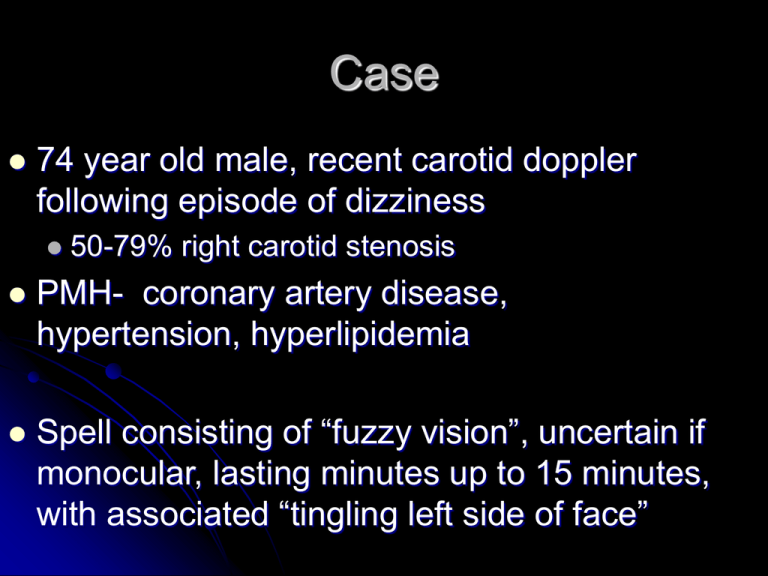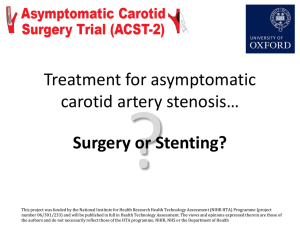
Case
74 year old male, recent carotid doppler
following episode of dizziness
50-79% right carotid stenosis
PMH- coronary artery disease,
hypertension, hyperlipidemia
Spell consisting of “fuzzy vision”, uncertain if
monocular, lasting minutes up to 15 minutes,
with associated “tingling left side of face”
Questions
Is this amaurosis fugax?
What is this patient’s risk for stroke?
Is carotid endarterectomy indicated in this
case?
Amaurosis Fugax
…and the role of
Carotid Endarterectomy
COL Beverly Rice Scott MD
Neurology and Neuro-ophthalmology
Madigan Army Medical Center
Outline
Definition and etiologies of transient visual loss
Clinical features & pathophysiology
Evaluation of transient monocular blindness
Amaurosis Fugax and Stroke Risk
North American Symptomatic Carotid
Endarterectomy Trial (NASCET)
Spectrum of ocular ischemic syndromes and
stroke risk
Definition
Painless unilateral transient loss of vision,
partial or complete, related to retinal
arterial microembolization or
hypoperfusion
“fleeting darkness or blindness”
Retinal transient ischemic attack (RTIA)
transient monocular blindness (TMB)
Accounts for 25% of anterior circulation transient
ischemic attacks (TIAs).
Transient visual loss
Monocular
(TMB)
Binocular
Amaurosis
Fugax
Cortical Migraine
Heart disease
Transient Visual Obscuration
Retinal
Migraine
Arteritis
Etiologies:
Transient visual loss
Occlusive retinal artery disease
Atheroembolic, cardioembolic, arteritic,
hematological disorders, congenital, orbital tumor
Low retinal artery pressure
Ocular ischemia syndrome, arteriovenous fistula,
congestive heart failure, anemia
Optic disc disease and anomalies
Papilledema, Glaucoma, Drusen
Vasospasm (ophthalmic migraine)
Miscellaneous
Clinical Features:
Symptoms
Abrupt or gradual monocular* visual loss,
progressing from peripheral toward center of field
+/- descending/ ascending shade, partial or complete
‘looking through fog’
Visual disturbance: Dark, foggy, gray, white
Minutes (1-5 minutes, occasionally longer);
full resolution takes 10-20 minutes
Painless
Stereotyped
Usually occurs in isolation
*may be difficult to distinguish monocular from binocular visual
loss
Clinical features:
Retinal findings
Acute infarction
Opaque and gray (early)
“bright plaques” of cholesterol or other
microemboli; may persist weeks to years
Cotton-wool spot
Segmental arteriolar mural opacification
Optic disc pallor, arteriolar narrowing (late)
Hollenhorst Plaque
Retina and Vitreous, Basic and Clinical Science Course,
AAO 1996
Cotton-wool Spot
Retina and Vitreous, Basic and Clinical
Science Course, AAO 1996
Pathophysiology
Atheromatous degeneration and stenosis of the
cervical carotid arteries
Estimated 27% - 67% w/ amaurosis or retinal strokes
Retinal emboli
Cholesterol crystals
Platelet aggregates
Fibrin and blood cells
Neutral fat
Vasospasm
Primary thrombosis of retinal arteries does not occur
Pathophysiology
Microemboli occludes retinal vessels, then
fragment and pass into retinal periphery
If disaggregation with reconstitution of
blood flow does not occur, ischemic
damage to the inner retinal layers may be
irreversible
Branch Retinal Artery
Occlusion
Retina and Vitreous, Basic and Clinical Science Course,
AAO 1996
Evaluation:
Transient Monocular Blindness
Consider disorders with greatest morbidity and
most common disorders
Consider age, stereotypy of events
Physical exam (blood pressure, carotid/cardiac exam)
Ophthalmologic Exam
Visual acuity, visual fields, relative afferent pupil defect
dilated fundus exam (emboli, anomalous discs)
Visual fields
Electroretinogram – diminished B-wave
amplitude
Evaluation:
Transient Monocular Blindness
Over age 40
Under age 40
Migraine history, family
Echocardiogram w/
bubble
CBC, ESR, ANA,
antiphospholipid
antibodies
stop birth control pill
stop smoking
History for giant cell
arteritis, polymyalgia,
coronary artery disease,
stroke & risk factors
ESR, Creactive Protein if
older than 50)
Carotid Doppler
Echocardiogram w/ bubble
MRA , CT angiography
Fluorescein angiogram
Carotid angiography
Cerebrovascular disease
A spectrum of signs, symptoms,
and stroke risks
Low risk
Asymptomatic
High risk
Asymptomatic w/ signs
of atherosclerotic
Cerebrovascular disease
Symptomatic
Atherosclerotic
Cerebrovascular
disease
Amaurosis Fugax
and Stroke Risk
Isn’t if funny that I went blind
in the wrong eye”
CM Fisher. Transient monocular blindness associated with
hemiplegia. Archives Ophthalmology, 1952.
What is the relationship of AF and the other
ocular ischemic syndromes to the
carotid arteries?
Amaurosis Fugax (AF)
& Stroke Risk
Early studies and reports uncontrolled
Different populations
Causes aggregated
Best studied ocular ischemic syndrome
Prognosis following AF considered more
favorable than TIA, unless severe stenosis
Prognosis altered by carotid endarterectomy?
Stroke risk estimated 2-4% prior to NASCET
Carotid Endarterectomy (CEA):
Historical Perspective
1954: CEA introduced
1959-70: Joint Study of
Extracranial Arterial Occlusion
surgery: 32% stroke risk
medical: 39% stroke risk
operative M&M of 11.4%
CEA benefit if 3% morbidity
1970: 15,000 operations/yr
1980s: 100,000 operations/yr
Practical Neurology, Vol 4, 2005.
NASCET
1987-1996
North American Symptomatic Carotid
Endarterectomy Trial (NASCET)
2885 patients enrolled ; TIA/stroke 120 days
carotid stenosis; angio confirmed
1583 patients(54.9%) -- TIA
1302 patients (45%) – nondisabling stroke
moderate (30-69%) ; severe (70-99%)
Established CEA over medical RX in patients
with high grade stenosis (>70%)
NASCET
Medical
Surgical Absolute Rel Risk
Difference Reduction NNT
70-99%
26.0%
9.0%
17%
65%
8
50-70%
22%
16%
6%
39%
15
Cumulative risk for ipsilateral stroke in symptomatic
Carotid Endarterectomy trials at 2 years
< 50% , CEA not better than ASA (aspirin)
NASCET:
Amaurosis & Stroke Risk
The Risk of Stroke in Patients With First-Ever
Retinal vs Hemispheric Transient Ischemic
Attacks and High-grade Carotid Stenosis.
Archives of Neurology. 1995.
Prognosis after Transient Monocular Blindness
Associated with Carotid-Artery Stenosis. NEJM.
2001
NASCET Medical Subgroup:
High grade stenosis
129 patients with first TIA
59 retinal TIAs (RTIAs)
70 with hemispheric TIAs (HTIAs)
Characterize the features and course of
subgroups with high grade stenosis
Compare outcomes with RTIAs to HTIAs
Average follow-up: 19months
Arch Neurol. 1995; 52
NASCET Medical Subgroup:
High Grade Stenosis
HTIAs: older, higher risk factors
RTIAs: higher risk for smoking
Longer delay for medical treatment for
RTIAs
(48 days vs 15.2 days )
Estimates for stroke risk at 2 years
RTIAs 16.6% +/- 5.5%
HTIAs 43.5% +/- 6.7%
Arch Neurol. 1995; 52
NASCET Medical Subgroup:
Risk Factors w/ High Grade Stenosis
RTIA (n=59)
HTIA (n=70)
Mean age
Male gender
hypertension
61.5
59%
59.3%
66.9
70%
64.3%
diabetes
heart attack
Angina
Claudication
17%
6.8%
27.1%
13.6%
21%
18.6%
40%
15.7%
Hyperlipidemia
30.5%
40.0%
Smoking (5yrs)
Antiplatelet Rx
61%
20.3% (delayed, 48d)
51.4%
25.7% (15 d)
NASCET Medical Subgroup:
Outcomes w/ High Grade Stenosis
RTIA (n=59)
Ipsilateral stroke, minor
7
HTIA (n=70)
17
major
0
8
retinal
1
2
0
0
0
1
0
1
2
2
Contralateral stroke
retinal stroke
Vascular death
MI
Arch Neurol. 1995; 52
NASCET Surgical Subgroup:
Outcomes
328 surgically treated patients
5.8% perioperative stroke
9% 2 year stroke rate
54 surgical treated patients with RTIA
2 minor perioperative strokes (4%)
One stroke (2%) 17 months post-op
6.8% stroke risk at 2 years
NASCET:
Amaurosis & Stroke Risk
The Risk of Stroke in Patients With First-Ever
Retinal vs Hemispheric Transient Ischemic
Attacks and High-grade Carotid Stenosis.
Archives of Neurology. 1995.
Prognosis after Transient Monocular
Blindness Associated with Carotid-Artery
Stenosis. NEJM. 2001
NASCET Subgroups:
Prognosis of TMB (transient
monocular blindness)
Compared 397 patients with isolated TMB
(medical and surgical subgroups) to 829
patients with hemispheric TIAs
Compared stroke risk for TMB and HTIAs in
patients with high grade stenosis with and
without collaterals
Identified risk factors for ipsilateral stroke in
patients with carotid stenosis > 50%
NASCET Subgroups:
Prognosis of TMB
HTIAs: older, higher risk factors
TMB: higher risk for smoking, increased high
grade stenosis, higher incidence of collaterals
Medically treated TMB had 3 year ipsilateral
stroke risk approx ½ HTIA
Surgically treated TMB showed 30-day stroke
rate ½ of HTIA (3.6% vs 7.4%)
Stroke risk increased with degree of carotid
stenosis and specific stroke risk factors
NASCET Med/Surg Subgroups:
Isolated TMB vs TIA
ICA stenosis
< 50%
50-69%
70-94%
Near occlusion
TMB
Hemispheric TIA
(N=397)
(N=829)
28.5%
50%
30.5%
31.7%
9.3%
29.8%
16%
3.7%
NEJM. Vol 345,2001
NASCET Med/Surg Subgroups:
Isolated TMB vs TIA
TMB
(N=397)
Collateral
Circulation *
24.2%
Hemispheric
TIA (N=829)
6.9%
*Collateral circulation = filling of the ACA, PComA, or
ophthalmic artery
NEJM. Vol 345,2001
NASCET Med/Surg Subgroups:
Three year stroke risk
NASCET Medical Subgroups:
Collaterals & 3 year stroke risk
TMB w/ collaterals (N=25)
HTIAs w/ collaterals (N=30)
TMB w/o collaterals (N=44)
HTIAs w/o collaterals (N=69)
2.9%
16.7%
16.0%
44.4%
NEJM. Vol 345,2001
NASCET Med/surg Subgroup:
Isolated TMB (N=397)
Median # of TMB episodes: 3 (1-7)
5%
Median
5%
had >45 episodes
duration : 4 minutes (1-10min)
had episode > 60min
No
correlation to carotid stenosis
3 year stroke risk (N= 198, medical)
1
episode -- 10.4 %
>2 episodes-- 8.2 %
NEJM. Vol 345,2001
NASCET Medical Subgroup:
Stroke Risk Factors
TMB with > 50% stenosis
Age > 75
Male sex
h/o hemispheric TIA or stroke
h/o intermittent claudication
Ipsilateral stenosis 80-94%
No collaterals on angiography
NEJM. Vol 345,2001
Amaurosis Fugax & Stroke Risk:
NASCET findings
TMB has high stroke risk if high grade
carotid stenosis, though less than HTIAs
Higher collaterals improve prognosis
Age, gender, h/o stroke/TIA,& claudication
may alter stroke risk
CEA reduces stroke risk if surgeon has low
complication rate
Perioperative risk for stroke and death was
lower in patients with TMB
Spectrum of clinical stroke risk
Low risk
Asymptomatic
Stenosis (2%)
High risk
Amaurosis
Fugax (2% -?6%)
BRAO
Asymptomatic
Bruit (2%)
Asymptomatic
retinal emboli
AION
Minor
Stroke (6.1%)
TIA
(3.7%)
Major Stroke
(9%)
Acute & Chronic Ocular
Ischemic Syndrome
Estimated Annual Stroke Rates
Conclusions
Amaurosis Fugax is caused by ischemia to the
retina, often associated with carotid stenosis,
and is a risk factor for stroke
Prognosis is better for patients with amaurosis
fugax treated both medically and surgically
compared to patients with hemispheric TIAs.
Amaurosis Fugax should be recognized, with
strong consideration for carotid endarterectomy
with high grade carotid stenosis, vascular risk
factors present, and low complication rate of
procedure in your center
References
Benavente, et al. Prognosis after Transient
Monocular Blindness Associated with Carotid
Artery Stenosis. NEJM, Vol 345(15), 2001.
Easton and Wilterdink. Carotid Endarterectomy:
Trials and Tribulations. Ann Neurology. Vol
35.1994.
Glaser. Neuro-ophthalmology. 3rd ed. 1999
Mizener, et al. Ocular Ischemic Syndrome.
Ophthalmology, Vol 104, 1997.
Rizzo. Neuroophthalmologic Disease of the
Retina. Neuro-ophthalmology.
References
Sacco et al. Guidelines for Prevention of Stroke
in patients with ischemic stroke or transient
ischemic attack. Stroke. Feb 2006.
Streifler, et al. The Risk of Stroke in Patients
with First-Ever Retinal vs Hemispheric Transient
Ischemic Attacks and High-grade Carotid
Stenosis. Archives of Neurology, Vol 52(3),
1995.
Wilterdink and Easton. Vascular event rates in
patients with atherosclerotic cerebrovascular
disease. Arch Neurology. Vol 49. 1992








